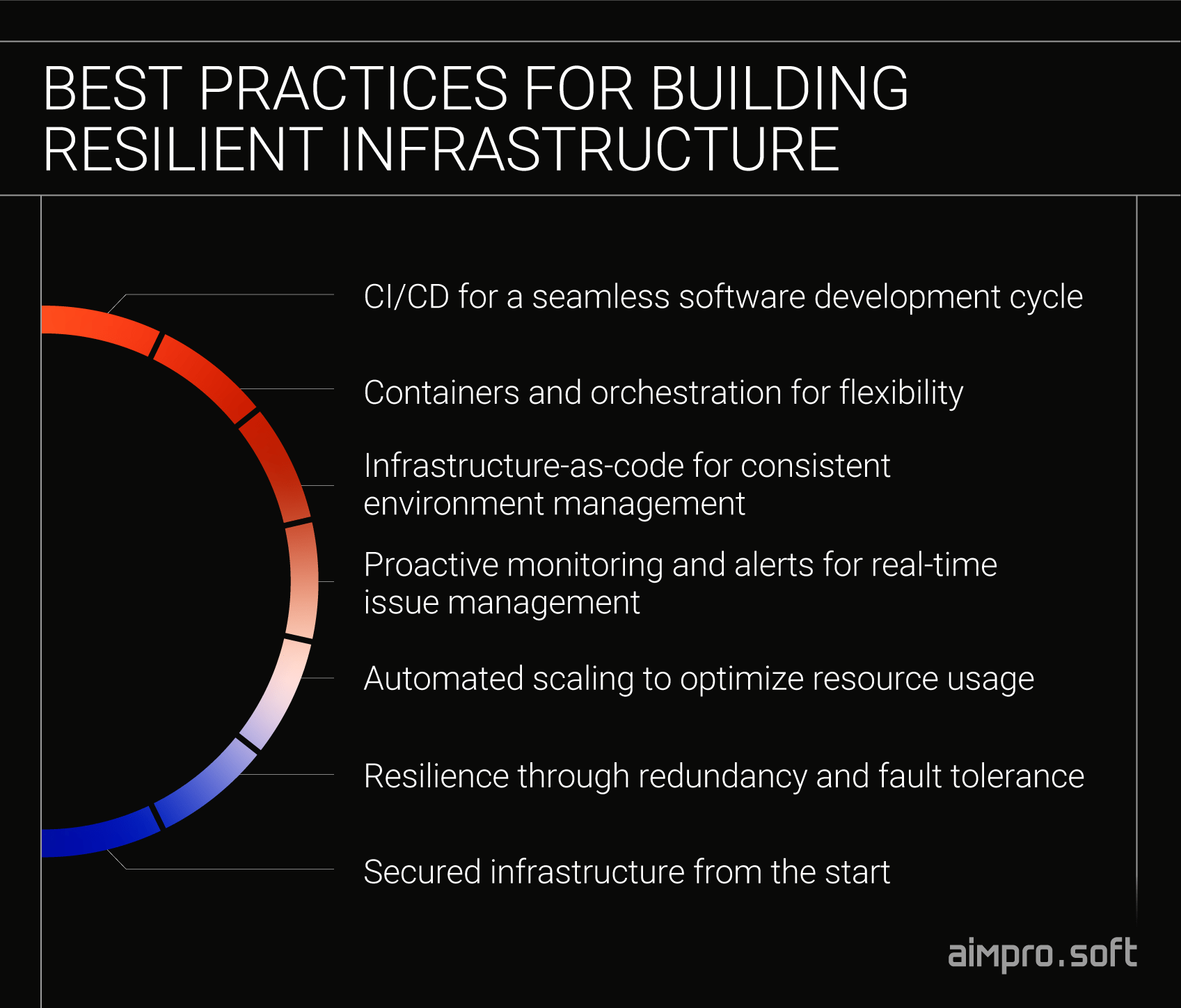Guide to Building Resilient Infrastructure for Social Media Apps: CI/CD, Containers, and DevOps Strategies
Building resilient infrastructure for a social media app startup or any similar product that must remain responsive under high load conditions and scale rapidly is similar to designing an efficient highway system. The infrastructure should accommodate traffic that can surge unpredictably, ensuring smooth flow at all times. Just as highways need multiple lanes, ramps, and bridges to manage everything effectively, high-load environments demand infrastructure that can not only scale but also withstand unexpected scenarios, whether it’s spikes in traffic and user activity or new feature releases.
In this article, we’ll share proven strategies for developing scalable and resilient infrastructure with optimized resource allocation in mind, focusing on key DevOps practices like CI/CD, container orchestration, dynamic scaling, and others. We’ll also showcase how we, as an IT infrastructure services provider, used these best practices while developing the Reekolect project, where we handled both technological and budgetary challenges to create a platform that could grow smoothly and handle the evolving needs of its users. So, let’s discover how to ensure your infrastructure is built to last.
Key risks when resilient infrastructure is overlooked in startup projects
Building a scalable and reliable infrastructure is often seen as a “future concern” for startups, but overlooking it during MVP development can have severe consequences down the line. Understanding the risks associated with skipping resilient infrastructure can help you understand the value of investing in robust solutions from the outset.

Risks of overlooking robust infrastructure in startup projects
1. Risk of failing to handle user growth
Without resilient infrastructure, you may face the risk of failing to handle user growth effectively. Social media apps or conceptually similar platforms can go viral overnight, and if the infrastructure isn’t prepared for a sudden surge of users, it can lead to overloaded servers, significant downtimes, and poor performance. Scalability is a critical factor, and cloud computing here provides the flexibility required to handle unpredictable loads.
According to the Oracle report, 41% of C-level executives consider scalability as a top benefit of cloud computing, underscoring its strategic value in ensuring a seamless user experience. Startups, however, may often underestimate this important factor, jeopardizing their user retention potential and ability to gain a competitive advantage.
2. Risk of uncontrolled infrastructure costs
One of the key risks associated with poor planning is the uncontrolled increase of infrastructure costs. Startups frequently launch MVPs without considering the long-term implications of infrastructure expenses. As user numbers increase, these costs can increase unpredictably, especially when services aren’t optimized for scalability.
A lack of visibility and poor cloud management practices are key drivers of uncontrolled cloud costs, with nearly 50% of businesses struggling to control these expenses, according to an Anodot survey. Unchecked growth in cloud IT infrastructure costs can cripple your budget, preventing you from directing investments in crucial areas such as marketing or new features.
3. High downtime risk
When resilient infrastructure is not put in place, and backup and fail-safe mechanisms are often overlooked, it may lead to a significant risk of frequent downtimes. Without load balancers, failover systems, and redundancy measures, infrastructure becomes vulnerable to single points of failure.
Thus, according to Forbes, IT downtime costs $9,000 per minute for large organizations, while for small businesses, the amount may vary from $137 to $427 per minute. As you can see, even brief outages can have a disastrous impact on your product’s stability and user experience. Leveraging small business outsourcing services can help mitigate these risks by ensuring that infrastructure is managed professionally and downtime is minimized. Prolonged downtimes can drive users away permanently and severely damage your brand’s reputation before it even has a chance to establish itself.
4. Inefficiencies caused by the wrong choice of technologies
Poor tool selection during the initial stages of infrastructure planning is a major risk for startups. There are numerous container orchestration, monitoring, and deployment tools available, but each comes with specific strengths and limitations. Choosing the wrong tools can create inefficiencies, complicate scaling, and force costly reconfigurations or migrations down the line. This can often lead to wasted resources, slowed productivity, and, ultimately, a product that falls short in both functionality and reliability.
5. Security and compliance risks
Security and compliance often get deprioritized in the MVP rush, leading to significant risks for social media apps, which are prime targets for breaches. A failure to incorporate security best practices during infrastructure planning can expose user data to potential breaches and result in hefty compliance fines. According to IBM, the average cost of a data breach in 2024 is $4.88 million, an amount that could easily sink a startup. Neglecting security not only risks regulatory penalties but also damages user trust, which, in the social media industry, can be impossible to regain.
Ignoring the importance of resilient infrastructure can lead to severe, often irreversible, outcomes for startups, from scalability issues and uncontrolled costs to repeated downtimes, inefficient operations, and security vulnerabilities. Addressing these risks upfront is crucial to building a reliable and future-proof platform. Hence, let’s explore best practices that can help you build resilient infrastructure, transforming these risks into opportunities for growth.
Best practices for building resilient and scalable infrastructure for social media platform MVP
Creating a scalable and resilient infrastructure is key to ensuring a smooth launch and future growth for your social media MVP. By opting to outsource DevOps services, you can leverage expert skills to set up and manage this infrastructure more efficiently, freeing your team to focus on core product development. Based on our expertise, we gathered some of the most reliable best practices that we recommend considering at this stage.

Best practices for building robust IT infrastructure
1. Implement CI/CD for a seamless software development cycle
Building Continuous Integration and Continuous Delivery (CI/CD) pipelines ensure seamless integration of code, automated testing, early bug and integration issues detection, and rapid deployment. For MVPs, the ability to deploy changes quickly and reliably is a crucial part of growth, especially when iterating based on early user feedback. Automating your deployment reduces human error, saves time, and ultimately speeds up the development process while maintaining consistency across environments. Proven tools like Jenkins, GitLab CI, and CircleCI are popular for building these workflows efficiently.
2. Use containers and orchestration for flexibility
Containerizing applications helps streamline the deployment process and makes your application portable across environments. By using orchestration tools like Kubernetes or Amazon ECS, teams can ensure scalability, automate deployments, and optimize resource usage. Containers also simplify testing, enabling consistent environments from development to production. For social media platforms dealing with high-load demands, container orchestration ensures that the system is capable of dynamically adjusting resources according to load, preventing downtime while maintaining optimal performance.
3. Infrastructure-as-code for consistent environment management
Infrastructure-as-code (IaC) helps manage and provision infrastructure through machine-readable configuration files rather than physical hardware setup. Tools like Terraform, Ansible, or AWS CloudFormation help maintain consistent environments, reduce risks of human errors, increase the speed of deployments, and make scaling easier. This practice is invaluable for MVP development, where environments must be quickly replicable and adjustments are frequent. IaC ensures that infrastructure configurations are version-controlled and auditable, making it easier to track changes and prevent configuration drift.
4. Proactive monitoring and alerts for real-time issue management
Ensuring that your infrastructure remains healthy is a core aspect of maintaining resilience, especially for MVPs. Implementing proactive monitoring through tools like Prometheus, Grafana, or AWS CloudWatch allows you to track performance, set up alerts for unusual activity, and address bottlenecks before they become critical. Metrics such as CPU utilization, memory consumption, and request latency help provide early warnings of potential issues. This is especially important for social media apps, where user experience is paramount, and any latency or downtime can lead to user churn.
5. Automated scaling to optimize resource usage
Scalability is at the heart of resilient infrastructure, particularly for social media apps where unpredictable traffic spikes are common. Auto-scaling tools, such as AWS Auto Scaling Groups or Kubernetes Horizontal Pod Autoscaler, enable the automatic adjustment of resources based on current demand. It means that it prevents assigning more resources than are actually needed, ensuring that infrastructure adjusts efficiently to user demand without incurring extra, unnecessary costs.
6. Resilience through redundancy and fault tolerance
Designing infrastructure for redundancy ensures that the application can tolerate faults or failures without impacting the user experience. A common approach includes load balancing, data replication, and backup solutions. By designing for failure, you make sure your startup doesn’t crash if one component shuts down. Redundant databases, backup instances, and automated failover mechanisms are essential parts of a resilient social media app. Implementing these practices prevents single points of failure and ensures high availability, which is crucial for maintaining user trust.
7. Secure your infrastructure from the start
Security should be embedded into the infrastructure from day one. From setting appropriate IAM (Identity and Access Management) roles to prevent unauthorized access to using Web Application Firewalls (WAF) to prevent common attacks, security is a vital part of building resilient infrastructure. DevOps practices, such as integrating security into development (DevSecOps), using automated security testing, and regularly updating dependencies, help ensure that both applications and data remain secure.
Vulnerability scanning, automated patching, and compliance audits also contribute to a secure setup. For a startup, strengthening security from early stages ensures that any subsequent iterations are built on a strong foundation, reducing the risk of costly breaches.
Strategic value
Applying proven DevOps practices to build resilient, robust, and scalable infrastructure for a startup offers significant strategic advantages that extend beyond technical gains. Using IT outsourcing for startups can further enhance these advantages by providing the expertise required to set up resilient infrastructure without the overhead of hiring full-time staff. Here are some key strategic benefits:
- Faster time to market. Efficient CI/CD practices reduce deployment times, allowing you to automate manual tasks, streamline development processes, and release updates and new features faster.
- Reduced long-term costs. Investing in scalability and monitoring prevents costly downtime and emergency fixes, optimizing operational costs as user numbers grow.
- Investor confidence. Robust infrastructure demonstrates foresight and reliability, making your startup more appealing to potential investors.
- Adaptability and growth. With an infrastructure built to scale, startups are better equipped to handle sudden growth, ensuring a smoother transition from MVP to a full-fledged product.
By investing in these infrastructure practices early on, you can position your product strategically for growth, reduced risks, and sustainable scaling, all of which are crucial for a competitive edge in the social media market. Using AWS DevOps outsourcing allows startups to build resilient infrastructure while focusing on core business activities efficiently.
Overall, building resilient and scalable infrastructure for social media MVPs requires establishing seamless deployment cycles, automated scaling, proactive monitoring, and strong security. By following these best practices, you can ensure that their MVP is well-prepared to handle both the technical and business challenges that come with growth. Before illustrating how we applied these practices to the Reekolect project, it’s important to address another point, namely, when hiring a DevOps specialist as part of a software outsourcing service for your startup is a worthy investment and when it may be redundant.
When to hire a DevOps specialist for your startup project
In the early stages of product development, startups may often question whether investing in DevOps is necessary or whether the work can be handled by developers themselves. This section will help you understand the scenarios when hiring a DevOps specialist is crucial and when it might not yet be the right time. By understanding the value of software outsourcing and outstaffing, you can decide whether to bring in specialized talent early on or to manage development with existing resources.
When to hire a DevOps specialist
- Complex infrastructure requirements. If your MVP involves cloud infrastructure, multiple environments (development, staging, production), and aims for scalability from the beginning, software engineer outsourcing can be crucial. Bringing in a DevOps specialist through outsourcing helps to architect and manage the infrastructure effectively.
- Frequent code releases. When your development cycle requires rapid iteration, feature releases, and continuous deployment, a DevOps professional can set up CI/CD pipelines to streamline and automate the release process, reducing both time and errors.
- Need for scalability and high availability. For high-load platforms, such as social media apps, a DevOps engineer can implement tools to ensure scalability and fault-tolerance, making sure your infrastructure can dynamically adapt to changes in loads.
- Cost optimization. If managing cloud resources and cost efficiency are priorities, DevOps can help by using IaC practices, automated scaling, and proactive monitoring to prevent excessive spending while ensuring optimal performance.
When you don’t need a DevOps specialist
- Small projects or MVPs with limited features. If your startup is small-scale, with no complex deployment or scaling requirements, then relying on a developer with basic cloud knowledge might suffice, at least initially.
- Static and limited infrastructure. If your infrastructure requirements don’t involve scaling or dynamic environments, you may be able to delay hiring a DevOps expert until you reach the point where scalability is needed.
- Budget constraints. If the budget is limited, it might make more sense to invest in basic hosting solutions or simpler cloud environments. In such cases, focusing on getting a minimal, functional MVP may have a higher priority, with DevOps IT infrastructure management services being a consideration for the growth phase.
Deciding when to hire AWS cloud engineers is a balance between the complexity of your infrastructure, the speed and frequency of releases, and budget constraints. While early investment in DevOps can provide long-term gains, it is important to assess whether the current stage of your project justifies the investment. Outsourcing software development to a dedicated team can be a strategic choice, allowing you to bring in specialized skills like DevOps only when they’re truly needed for effective growth and scalability.
Reekolect as an example of resilience: building reliable and cost-efficient infrastructure
The Reekolect project began with an ambitious idea from our client: to create a social media platform similar to Facebook but uniquely focused on preserving memories and capturing important milestones. This vision required a strategic approach to outsourcing custom software development to ensure efficient execution while managing complexities like AI photo processing, family trees, and growing social connections. However, the journey was not without its challenges.
The client opted for our outsourcing software development services and came to us with only a broad vision, lacking a clear roadmap, and having a fixed budget in mind. They were eager to create a robust, scalable MVP, a goal that required a strategic and efficient approach to infrastructure and development.
From the initial planning stages, our custom software outsourcing approach integrated DevOps expertise into the project, which turned out to be a pivotal factor in maintaining a balance between scalability, reliability, and cost efficiency. We began with infrastructure planning and estimating, collaborating closely with the development team to outline an architecture that could grow with user demands. Early decisions about technologies, architecture, and the overall stack ensured alignment right from the start, setting a solid foundation for what would become a complex social platform.
As the project progressed, our DevOps specialist provided managed IT infrastructure services, taking on a number of critical tasks, ultimately ensuring that the infrastructure would not only meet the demands of the MVP but be prepared for future scaling and enhancements.
Key DevOps activities and best practices applied
- Cloud environment configuration: AWS was selected as the cloud provider, and the environment was meticulously configured, from account creation and user access setup to deploying development, staging, and production environments.
- CI/CD pipeline implementation: Custom CI/CD automation was written from scratch for all code repositories. This ensured that code integration and deployments were efficient, reducing manual errors and streamlining the entire development process.
- Infrastructure as Code (IaC): We used Terraform combined with Terragrunt to write infrastructure code that supported multi-account, multi-environment setups. This not only made infrastructure replicable and consistent but also facilitated swift scaling when needed.
- Proactive cost analysis and optimization: A constant analysis of AWS billing allowed us to identify and eliminate unnecessary costs, such as replacing expensive VPC endpoints and NAT gateways with more cost-efficient alternatives, namely ECS service discovery and NAT instances.
- Dynamic container scaling: Scaling the ECS containers to create dynamic environments allowed us to adjust resources to meet changing demands autonomously. This led to maintaining consistent expenditure and achieving lower costs compared to static container setups.
- High availability and fault tolerance: Throughout the infrastructure, we followed principles of High Availability, Fault Tolerance, and Durability. This included setting up load balancers, auto-scaling groups, and using distributed databases, all aimed at keeping Reekolect functioning even during unforeseen challenges.
Explore the full story behind Reekolect’s development. Dive into the detailed journey of how we built a reliable, cost-efficient infrastructure for Reekolect. Learn about the key decisions, challenges, and strategies applied.
Outcomes
- Infrastructure efficiency: We successfully adhered to the estimated infrastructure costs, eventually reaching only 80-85% of the initial estimate, effectively reducing costs by 15-20%.
- Cost savings on resource allocation: The implementation of dynamic container scaling contributed to keeping costs stable and, theoretically, reduced container expenses by up to 50% compared to static setups.
- Backend optimization: Compressing and converting photo files using AWS Lambda reduced backend resource demands by 15-20% and increased processing speed by 10-15%.
- AI cost optimization: The GPU instance optimization led to a 70% cost reduction on the AI processing portion of the platform, showcasing our focus on smart resource management.
- External audit success: Our infrastructure setup passed an audit conducted by an external consulting firm, which enabled the project to continue seamlessly and validated our expertise and the project’s resilience.

Reekolect social media app
Overall, the Reekolect project is a testament to how meticulous planning, efficient DevOps managed services, and strategic infrastructure choices can inform how to build a cloud computing infrastructure that is both scalable and cost-effective. By combining innovative DevOps practices with a focus on efficiency and resilience, we helped create a reliable social media platform ready for future growth, all while maintaining control over costs.
Conclusion
Building resilient and scalable infrastructure for a social media platform requires strategic planning, smart technology choices, and a robust DevOps approach. By using managed services for IT infrastructure along with best practices such as CI/CD implementation, container orchestration, proactive monitoring, and infrastructure as code, you can overcome key challenges in building a reliable MVP. The Reekolect project serves as an example of how these practices can successfully bring an ambitious idea to life while controlling costs and mitigating risks.
If you’re ready to explore how opting for DevOps outsourcing services at Aimprosoft IT outstaffing company can help build resilient infrastructure for your current project, don’t hesitate to contact us.
FAQ
How much does it cost to build resilient infrastructure for a social media MVP?
The cost of building resilient infrastructure can vary depending on the scope of features, choice of technology stack, cloud service costs, and the extent of IT infrastructure automation implemented. Generally, outsourcing IT infrastructure management services and utilizing cloud platforms like AWS, combined with cost-efficient practices such as dynamic scaling and container orchestration, can help control expenses.
How does containerization benefit my MVP’s infrastructure?
Containerization ensures your MVP is portable, consistent across environments, and scalable. By using IT outstaffing services, you can bring in skilled specialists to manage containerization effectively, reducing compatibility issues across different environments. Tools like Docker, along with orchestration services like Kubernetes or ECS, allow your infrastructure to grow seamlessly based on user demand, helping ensure reliability even under unpredictable traffic loads, which is crucial for any social media platform’s success.
What tools do you use to automate infrastructure and deployment?
At Aimprosoft IT outsourcing software development company, we use a variety of DevOps tools to streamline and automate infrastructure management and deployment. As part of our IT infrastructure outsourcing services, we utilize Terraform combined with Terragrunt for infrastructure as code (IaC), which helps maintain consistent environments. For CI/CD, we use tools like GitLab CI to automate testing, integration, and deployment, which speeds up the development cycle while reducing human errors. These tools are essential to achieving a reliable and agile development process
How do you ensure cost efficiency in cloud spending for high-load projects?
If you decide to hire DevOps engineers or hire software developers through outsourcing at Aimprosoft, we’ll proactively monitor cloud expenses and use various tools such as auto-scaling to provision only resources when needed. For instance, when providing IT infrastructure managed services while developing Reekolect platform, we optimized resource allocation, replacing expensive setups with cost-effective alternatives and reducing overall AWS expenditures by at least 10%. This kind of analysis helps keep cloud costs predictable while ensuring scalability.




